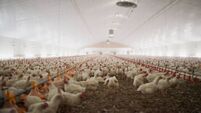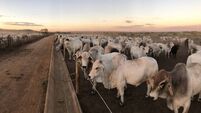Bird flu causes disruption to Chinese poultry imports

A government worker disinfects a poultry farm in Indonesia's Aceh province. Picture: CHAIDEER MAHYUDDIN/AFP via Getty Images
Bird flu in Argentina has left China without approximately 7% of its huge chicken imports.
Argentina is the third largest supplier of chicken products to China, but self-suspended its exports after finding highly pathogenic avian influenza (HPAI) in commercial poultry.
Bird flu is on the rise throughout the world, and if it spreads further across South America, China could find it harder to replace the suspended imports (in 2022, Argentina exported 43,000 tonnes to China).
With the disease hitting production of poultry meat and eggs globally, also under pressure from increased production costs, the price of eggs in the EU was 30% higher in January, year-on-year.
The disease has changed from a sporadic to a year-round threat to the poultry industry. The bird flu variant that has wreaked havoc globally emerged in 1996 in China.
Migratory birds from Asia spread the virus to domestic birds in a seasonal pattern, with reduced risk in the summer. Now poultry farms are at continuous risk.
This past year has seen Europe hit with the worst-ever wave of avian flu. There were more than 2,467 outbreaks in poultry in 2021-2022, resulting in the slaughter of 48 million domestic birds in 37 countries, to control spread. EU farmers get only partial compensation for bird flu losses and costs.
The EU has new rules to harmonise vaccination against bird flu, EFSA has been mandated to assess suitable vaccination strategies. But member states disagree on the merits of vaccination.
‘The fight against avian influenza is at the top of our priorities,’ European Health Commissioner Stella Kyriakides said last month.
Bird flu is also considered an ongoing threat to human health that needs constant monitoring, although the European Food Safety Authority (EFSA) says the risk of transmission to the general public remains low, despite new outbreaks reported in birds, and occasional infections in mammals.
So far, the virus remains poorly adapted to spreading humans. Infections in humans occur from time to time, but are rare, and usually due to close, prolonged and unprotected contact with infected birds.
But there have been at least 200 recorded cases in mammals, sometimes associated with feeding on the carcases of infected wild birds. Last week, bird flu was found in seals and porpoises on UK coasts.
Human health dangers increase if the virus becomes established in an intermediary mammal, most likely a pig. This could result in a more dangerous hybrid virus.
Ireland's most recent HPAI bird flu cases in poultry occurred in Co Monaghan last November.
But the virus still circulates in wild birds, and all Irish poultry owners, including backyard flock owners, are advised to implement strict biosecurity and minimise contact between their poultry and wild birds. They should regularly monitor for and report any signs of bird flu.
Poultry confinement regulations will be lifted when appropriate to do so, based on risk assessments.











